News Articles

Ben here with the Tuesday edition of #BenInNature presented by our friends at Carter Bank & Trust!
August 31, 2021
Ben here with the Tuesday edition of #BenInNature presented by our friends at Carter Bank & Trust! This week we're looking at some of the stinging insects that call Virginia home. Today's entry should be instantly familiar to most folks out there, although probably not in a good way: this is the eastern yellowjacket (Vespula maculifrons)! Eastern yellowjackets are wasps that are found from eastern North America west to the Great Plains, and they generally (but not always) build their nests underground. Like the paper wasps we looked at yesterday, the nests are constructed from wood pulp mixed with saliva. The nests are usually built just a couple inches underground, although they may also be built nearly a foot beneath ...
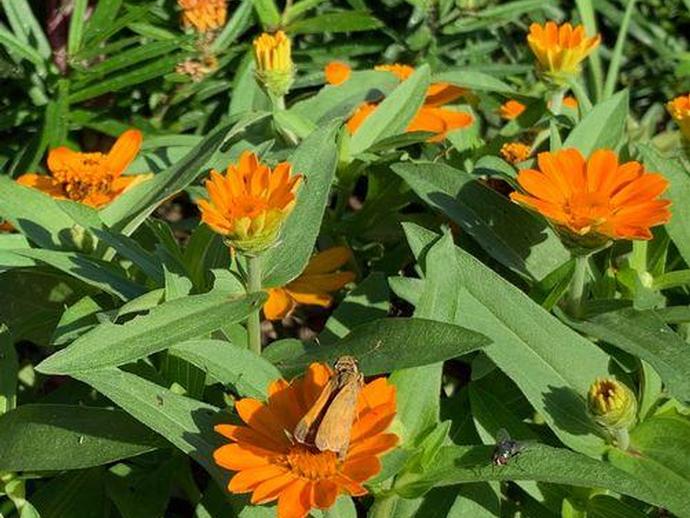
The Jim Tobin Monarch Waystation - located near the museum's front plaza - is teeming with life ...
August 30, 2021
The Jim Tobin Monarch Waystation - located near the museum's front plaza - is teeming with life and beauty today! #WhatWillYouDiscover?

It's time for the Monday edition of #BenInNature presented by our friends at Carter Bank & Trust!
August 30, 2021
It's time for the Monday edition of #BenInNature presented by our friends at Carter Bank & Trust! I'm back from vacation and I've decided to do a little something different this week! There are a whole slew of wasps, bees, and hornets out, and a lot of folks have reached out asking if they've spotted the dreaded "murder hornet," more accurately known as the Asian giant hornet (Vespa mandarinia). So far, these hornets have only been found in the Pacific Northwest, so they're not a concern for us here in Virginia. However, I thought it might be beneficial to spend a week looking at some of the stinging critters you ARE likely to see in this neck of the woods. We'll kick things off with the umbrella paper wasp (genus ...
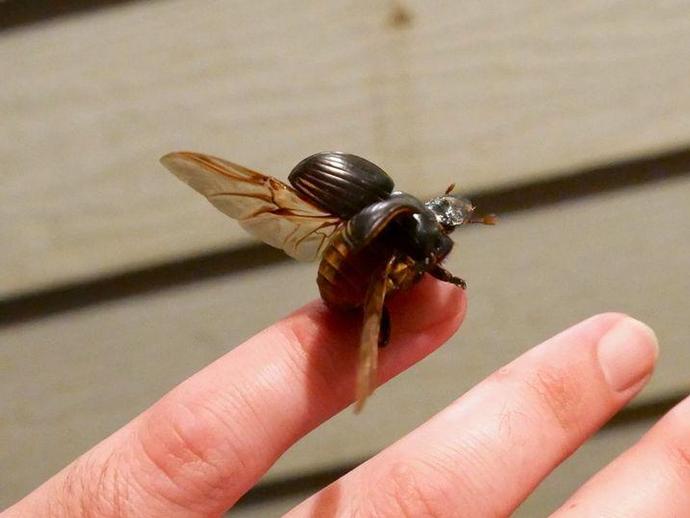
Ben is taking a well-deserved vacation this week ...
August 29, 2021
Ben is taking a well-deserved vacation this week, so we're reaching into the archives for today's #BenInNature update presented by our friends at Carter Bank & Trust! The following post was originally published on July 31, 2020. Sometimes I have to go out in search of critters to feature in these daily updates; at other times, the critters fly right into me with the force of an Airsoft pellet while I'm sitting on my back porch! This is Dichotomius carolinus, and it's the largest and heaviest dung beetle in the eastern US! When we think of dung beetles (and I guess some of us do more than others) we usually think of the large dung beetles of Africa that roll up little balls of dung and push them around. However, not all ...

Ben is taking a well-deserved vacation this week ...
August 28, 2021
Ben is taking a well-deserved vacation this week, so we're reaching into the archives for today's #BenInNature update presented by our friends at Carter Bank & Trust! The following post was originally published on July 30, 2020. The eastern cicada killer (Sphecius speciosus) is one of our largest and most impressive wasps -- especially if you happen to catch one doing what it does best. These solitary digger wasps can measure up to two inches long, with the females slightly larger than the males. The females need every bit of that size because they need the strength that comes with it. The adult wasps emerge in late June/early July and the females can often be spotted hovering over lawns looking for places to dig burrows. ...
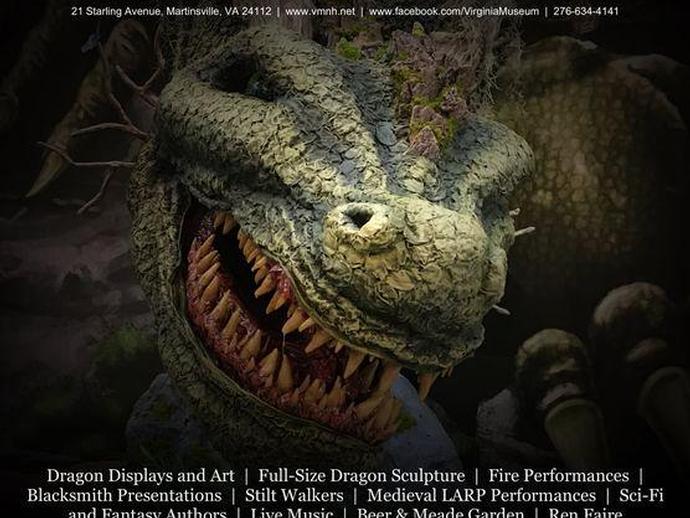
Science ...
August 27, 2021
Science, history and myth collide during Dragon Festival 2021 at the Virginia Museum of Natural History on Friday, October 15 and Saturday, October 16, 2021 from 10 a.m. to 6 p.m.! Explore the lore of dragons, the impact these creatures have had on societies across the globe, and the science behind the growth and dissemination of their myth! All of the sights and sounds that make the myth of dragons so alluring will be in full-force throughout the day! NEW THIS YEAR! This year's event features the Dragon Festival debut of Tiamat, an incredible 37 foot-long dragon designed and created by J. Leigh and The Color of Mud Studio! Visit the Dragon Festival 2021 event listing to learn more! #WhatWillYouDiscover

It's time for another Fossil Friday!
August 27, 2021
It's time for another Fossil Friday! Pictured is an unknown trilobite (group of extinct marine arthropods) only a centimeter long, possibly from the Early Cambrian Rome formation in Virginia. If you look carefully, you can see the facial suture on the cephalon or head. The suture is on the left side of the head to the right of the eye. Trilobites molted their shell along the facial suture as they grew. Venture a guess as to what family or genus this belongs? The answer will be posted next week! #WhatWillYouDiscover #FossilFriday
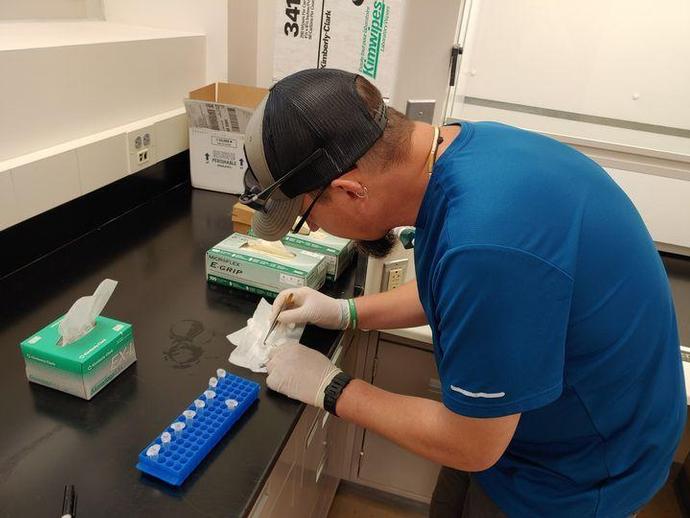
If you have been following developments at the museum lately ...
August 27, 2021
If you have been following developments at the museum lately, you may be aware that Associate Curator of Recent Invertebrates Dr. Kal Ivanov and Myriapodologist Dr. Jackson Means have been setting up a molecular lab at the VMNH. Well, we are excited to announce that the first DNA extraction has been conducted in the new lab, which included a variety of taxa, including millipedes, ants, and isopods! Dr. Means walked Dr. Ivanov and Biology Research Technician Liberty Hightower through the process and was impressed by how quickly the two field biologists took to molecular work. The new molecular lab will facilitate research at the museum, including the description of species new to science! We look forward to all of the ...
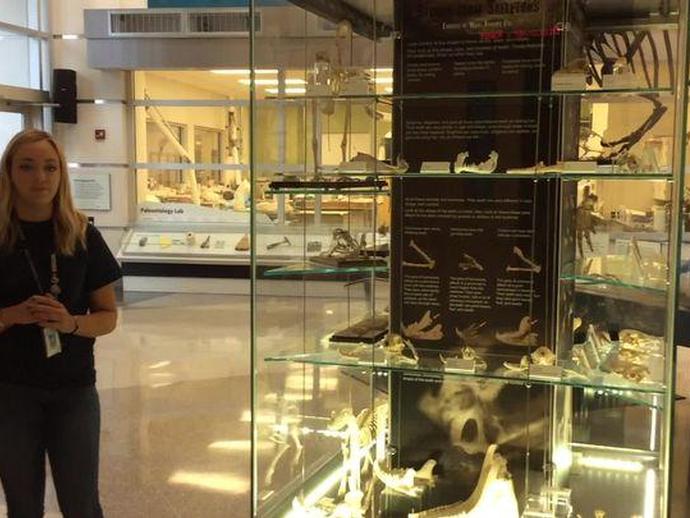
This week's episode of "Museum Minute" takes us inside the Harvest Foundation Hall of Ancient ...
August 27, 2021
This week's episode of "Museum Minute" takes us inside the Harvest Foundation Hall of Ancient Life, as we highlight the evidence of what animals eat! ABOUT MUSEUM MINUTE The Virginia Museum of Natural History has a spectacular assortment of displays within its exhibit galleries! Some displays are unforgettable, while others don't always get the attention they deserve. Through the original series "Museum Minute", museum educators highlight various displays throughout the exhibit galleries, while providing intriguing facts you may not have known. "Museum Minute" is made possible thanks to VMNH Corporate Partners Carter Bank & Trust (www.cbtcares.com) and Boxley Materials Company (www.boxley.com).

Ben is taking a well-deserved vacation this week ...
August 27, 2021
Ben is taking a well-deserved vacation this week, so we're reaching into the archives for today's #BenInNature update presented by our friends at Carter Bank & Trust! The following post was originally published on July 29, 2020. Today marks my 135th nature update, and I'm guessing that out of all the critters we've looked at, this one would rank #135 in terms of popularity. Dermacentor variabilis, better known as the American dog tick or wood tick, can spread a number of diseases, including Rocky Mountain spotted fever and tularemia (although it's not generally a vector for Lyme disease; the smaller deer ticks are mostly responsible for that one). However, if you'd like to learn the best way to stay safe from ticks of all ...
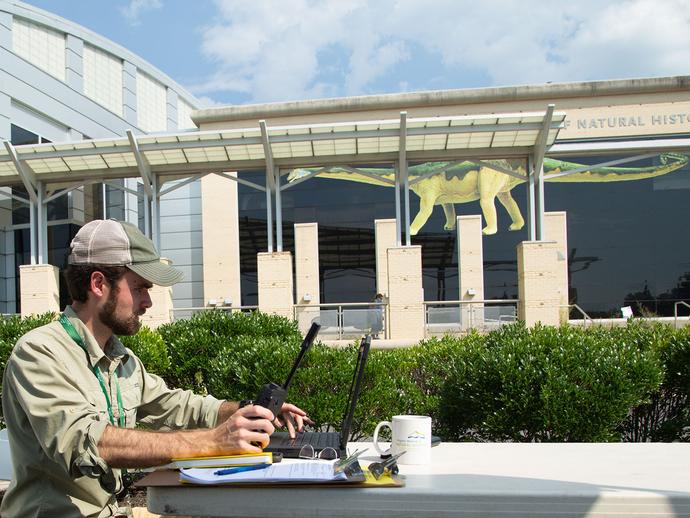
VMNH leads in the global monitoring of cultural heritage sites threatened by armed conflict and natural disaster
August 26, 2021
Did you know that the Virginia Museum of Natural History (VMNH) is a leader in the global monitoring of cultural heritage sites threatened by armed conflict and natural disaster?
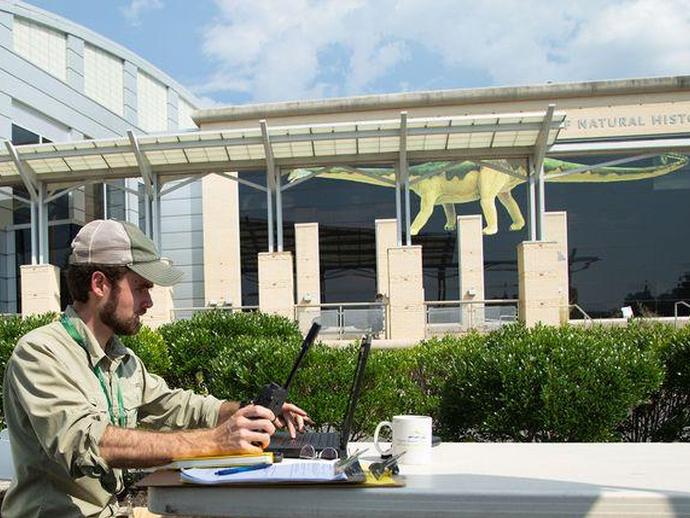
Did you know that the Virginia Museum of Natural History (VMNH) is a leader in the global ...
August 26, 2021
Did you know that the Virginia Museum of Natural History (VMNH) is a leader in the global monitoring of cultural heritage sites threatened by armed conflict and natural disaster? Through the recently formed Cultural Heritage Monitoring Lab (CHML), which is located at the museum and developed in partnership with the Smithsonian Cultural Rescue Initiative (SCRI), museum staff - along with a distributed workforce of archaeologists, art historians, GIS experts, and other heritage practitioners - are able to monitor threatened cultural heritage sites across the globe. CHML serves as the primary mission support lab for the US Army Reserve's recently reactivated Monuments Men (38G/6V) unit and also provides support for ...

Ben is taking a well-deserved vacation this week ...
August 26, 2021
Ben is taking a well-deserved vacation this week, so we're reaching into the archives for today's #BenInNature update presented by our friends at Carter Bank & Trust! The following post was originally published on July 28, 2020. "Gee Ben," you are perhaps thinking to yourself, "that's a real nice picture of a little piece of filth. Thanks for sharing this marvel of nature with us today." And sure, at first glance, this does look like a little pile of trash ... but that's exactly what the junk bug wants you to think! If you look closely, you can see a couple of little legs poking out from underneath this pile. This is the larvae of the green lacewing, which belongs to the family Chrysopidae! Green lacewings are fairly ...
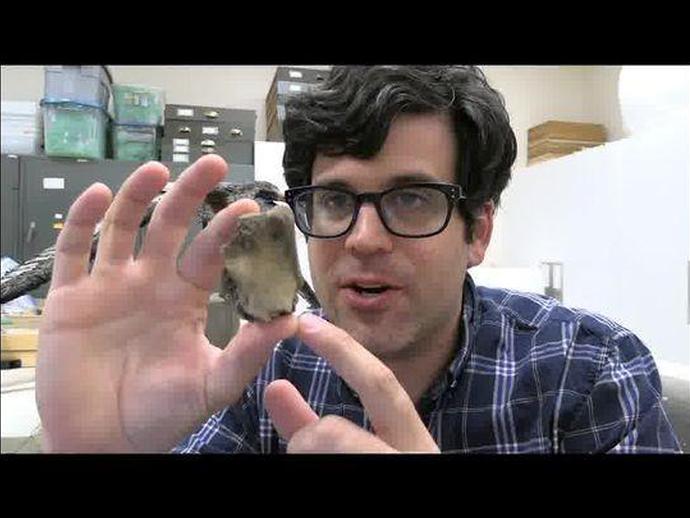
Assistant Curator of Paleontolgoy Dr
August 25, 2021
Assistant Curator of Paleontolgoy Dr. Adam Pritchard is back with another edition of "Tales of Ancient Life", as hehighlights the giant - and extinct - bird Pelagornis and how other museum collections interface with the collection of VMNH! Special thanks to Carter Bank & Trust (www.cbtcares.com) and Boxley Materials Company (www.boxley.com) for helping make this episode possible! ABOUT TALES OF ANCIENT LIFE Our planet has an incredible story to tell and VMNH Assistant Curator of Paleontology Dr. Adam Pritchard helps share it through his original video series, "Tales of Ancient Life". Dr. Pritchard uses spectacular fossils and other scientific specimens from the museum's paleontology collections to highlight the wonders ...

Ben is taking a well-deserved vacation this week ...
August 25, 2021
Ben is taking a well-deserved vacation this week, so we're reaching into the archives for today's #BenInNature update presented by our friends at Carter Bank & Trust! The following post was originally published on July 27, 2020. At first glance, you might think this is the dreaded bald-faced hornet (Dolichovespula maculata), a type of wasp known for being highly aggressive. As someone who once tried to knock down a bald-faced hornet nest that was not as abandoned as it appeared and then broke into a sprint that would have impressed Usain Bolt, I can attest to the terror of the bald-faced hornet. However, this is actually Monobia quadridens, also known as the four-toothed mason wasp, and it's a great ally to have around ...
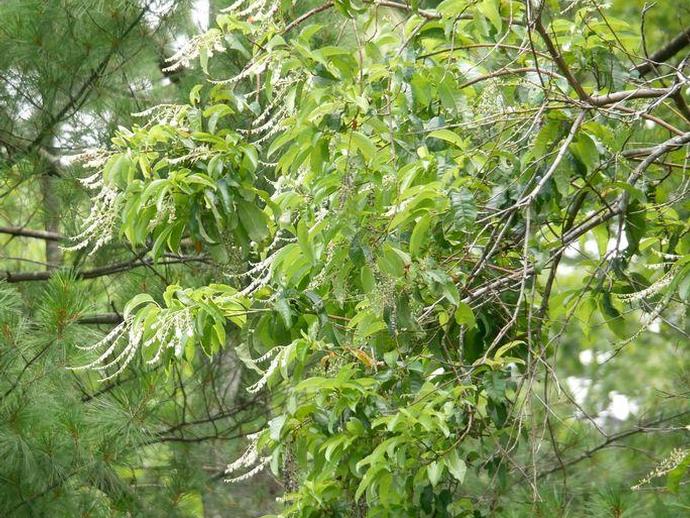
Ben is taking a well-deserved vacation this week ...
August 24, 2021
Ben is taking a well-deserved vacation this week, so we're reaching into the archives for today's #BenInNature update presented by our friends at Carter Bank & Trust! The following post was originally published on July 26, 2020. Oxydendrum arboreum, better known as the sourwood or sorrel tree, is the only species in its genus. It's native to eastern North America and is particularly common in the lower section of the Appalachians. Of course, if you're a fan of honey, you're probably very familiar with the sourwood tree. When bees collect pollen and nectar from the blooms of the sourwood, they produce sourwood honey, which is widely regarded as one of the finest varieties of honey you can find. Sourwood trees get their ...

We're reaching into the archives for today's #BenInNature update presented by our friends at ...
August 23, 2021
We're reaching into the archives for today's #BenInNature update presented by our friends at Carter Bank & Trust! The following post was originally published on July 25, 2020. If you have any milkweed growing near you, you've probably spotted a whole bunch of these small yellow insects covering the new leaves at the top of the plant. This is Aphis nerii, commonly called the milkweed aphid or the oleander aphid. It's believed that this aphid probably originated in the Mediterranean where it fed on oleander, which is its main host plant. However, it has since become widespread in tropical and warm temperate regions around the world. Perhaps the most remarkable fact about these aphids is that males have never been ...
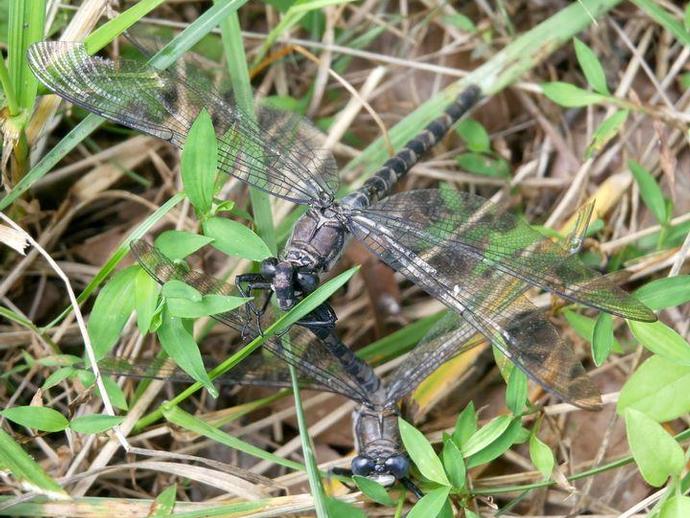
We're reaching into the archives for today's #BenInNature update presented by our friends at ...
August 22, 2021
We're reaching into the archives for today's #BenInNature update presented by our friends at Carter Bank & Trust! The following post was originally published on July 24, 2020. Now here's something you don't see everyday: two dragonflies preparing to mate! Before a weirdo with a camera interrupted their intimate moment, anyway. These are gray petaltail dragonflies (Tachopteryx thoreyi). This species was featured in my July 8 nature update; interestingly, they're considered fairly uncommon in Virginia, but I keep finding them at my place. So how do dragonflies mate? It's definitely not the easiest thing in the world. When the male spots an appropriate female, it uses special clasping structures at the end of its abdomen ...
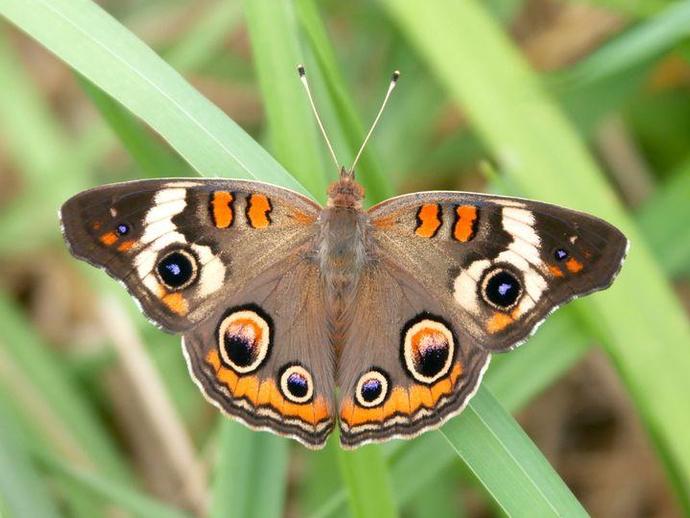
We're reaching into the archives for today's #BenInNature update presented by our friends at ...
August 21, 2021
We're reaching into the archives for today's #BenInNature update presented by our friends at Carter Bank & Trust! The following post was originally published on July 23, 2020. The common buckeye (Junonia coenia) is one of the most common butterflies in the southern U.S., and it can be found year-round in the southernmost parts of its range, including Mexico and parts of Central America. These small, beautiful butterflies are fairly easy to spot because their life cycle is connected to common prairie plants that thrive in areas disturbed by humans. If you find an open, sunny area with low vegetation, you've found a prime spot for common buckeyes! Interestingly, the caterpillars of these butterflies have to perform a ...
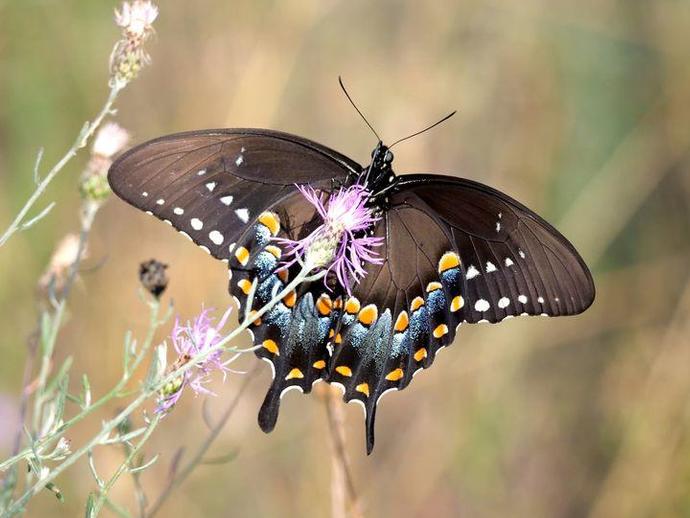
It's time for the Friday edition of #BenInNature presented by our friends at Carter Bank & Trust!
August 20, 2021
It's time for the Friday edition of #BenInNature presented by our friends at Carter Bank & Trust! Let's close out the week with one of my favorite butterflies: Papilio troilus, the spicebush swallowtail! While this butterfly looks superficially similar to the common black morph of the eastern tiger swallowtail (our state insect here in Virginia) there are some coloration differences which can mostly be spotted on the underside of the wings. As the name suggests, the caterpillars of these butterflies mostly feed on spicebush (genus Lindera), although they're also fond of white sassafras (Sassafras albidum). The adults, meanwhile, feed on nectar from a wide variety of flowers. One of the coolest features of the ...
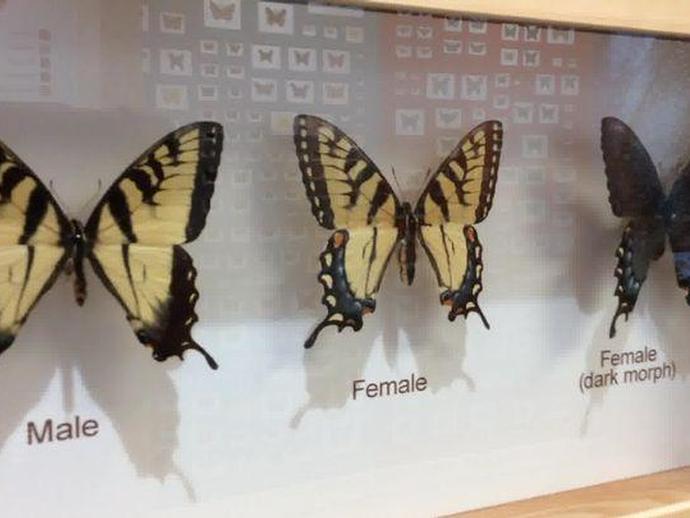
VMNH Education Manager Christy Deatherage is inside the museum's newest exhibit "Lepidoptera" to ...
August 20, 2021
VMNH Education Manager Christy Deatherage is inside the museum's newest exhibit "Lepidoptera" to highlight Virginia's state insect in this week's episode of "Museum Minute"! ABOUT MUSEUM MINUTE The Virginia Museum of Natural History has a spectacular assortment of displays within its exhibit galleries! Some displays are unforgettable, while others don't always get the attention they deserve. Through the original series "Museum Minute", museum educators highlight various displays throughout the exhibit galleries, while providing intriguing facts you may not have known. "Museum Minute" is made possible thanks to VMNH Corporate Partners Carter Bank & Trust (www.cbtcares.com) and Boxley Materials Company (www.boxley.com).

It's time for the Thursday edition of #BenInNature presented by our friends at Carter Bank & ...
August 19, 2021
It's time for the Thursday edition of #BenInNature presented by our friends at Carter Bank & Trust! I don't think there's a single harmless insect that elicits quite as much raw, seething hatred as the cave cricket (family Rhaphidophoridae). Also known as camel crickets, camelback crickets, and spider crickets (among other names), these little guys are perfectly harmless, yet people absolutely despise them. Maybe it's the long antennae, or the spider-like appearance, or the fact that they tend to invade basements, or the way they jump around erratically; whatever the reason, cave crickets ain't winning any popularity contests! There are more than 1,100 different species of cave cricket, all of which are flightless and ...

Ben here with another edition of #BenInNature presented by our friends at Carter Bank & Trust!
August 18, 2021
Ben here with another edition of #BenInNature presented by our friends at Carter Bank & Trust! When I joined several VMNH staff members on a field trip the week before last, we had to hike up a steep hill in order to gain access to New River Cave. Along the way, we spotted a favorite of mushroom hunters everywhere: genus Laetiporus, better known as chicken of the woods! These parasitic shelf mushrooms can be distinguished by their bright yellowish-orange color, and they tend to grow on oak trees. While they cause damage to the trees they grow on, they're prized by mushroom hunters for their flavor. Believe it or not, these mushrooms can be prepared in most of the same ways as chicken meat and are often used as a chicken ...
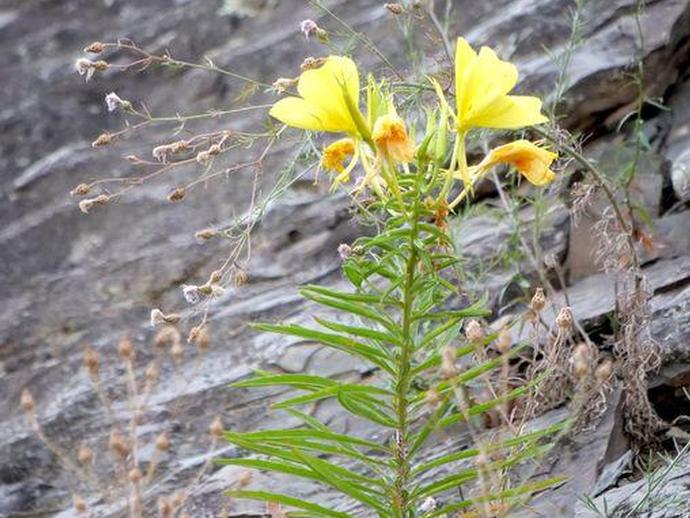
Ben here with today's edition of #BenInNature presented by our friends at Carter Bank & Trust!
August 17, 2021
Ben here with today's edition of #BenInNature presented by our friends at Carter Bank & Trust! While we visited tunnels and caves on our recent museum trip to Alleghany County and Giles County, we also found some neat specimens out in broad daylight; for example, Oenothera biennis, also known as common evening primrose! We found a ton of these plants growing on a shale slope, which isn't too surprising. These plants prefer sunny, dry conditions, and the seeds require light to germinate. The flowers bloom in the evenings from spring to late summer, and once bloomed, each flower only lasts until around noon the following day! Evening primrose was used by indigenous tribes in North America for centuries as both food and ...
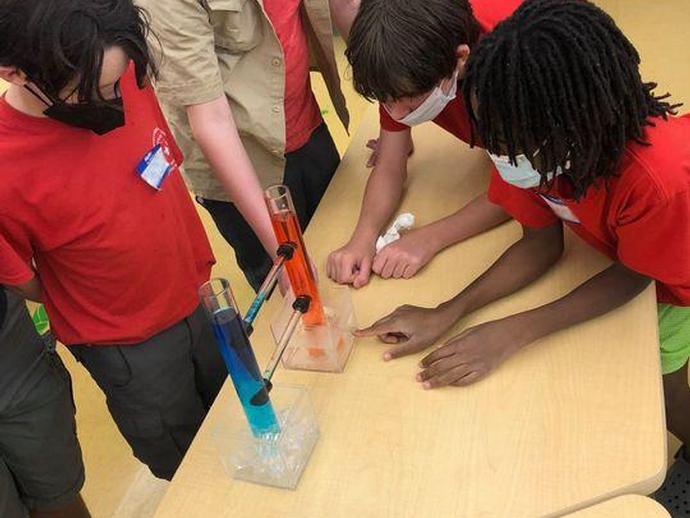
Boy Scouts from Newport News visited VMNH over the weekend for an onceanography-themed museum ...
August 16, 2021
Boy Scouts from Newport News visited VMNH over the weekend for an onceanography-themed museum sleepover! The Scouts took part in activities and crafts inside the museum's classrooms, toured the exhibits, and slept among the dinosaurs! If you're interested in scheduling your group for a museum sleepover, please visit www.vmnh.net/plan-your-visit/sleepovers or contact us today at discover@vmnh.virginia.gov!
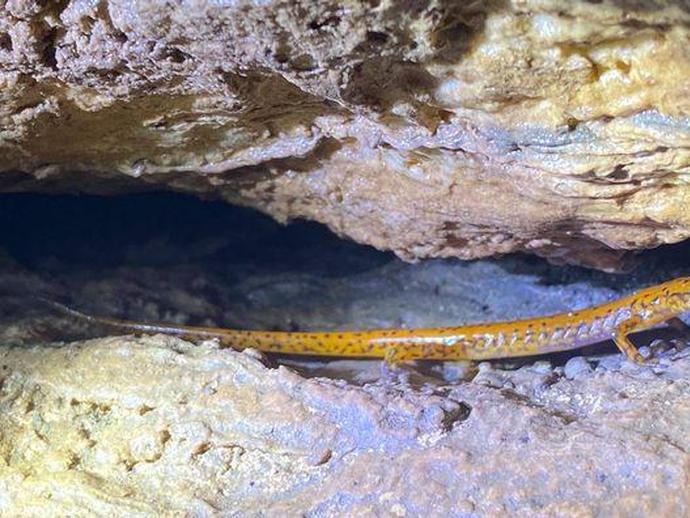
Ben here with the Monday edition of #BenInNature presented by our friends at Carter Bank & Trust!
August 16, 2021
Ben here with the Monday edition of #BenInNature presented by our friends at Carter Bank & Trust! Let's kick off the week with another cool find from the recent VMNH trip to Giles County: Eurycea lucifuga, the spotted-tail salamander or cave salamander! This salamander was one of several found inside New River Cave in Giles County, and they can generally be found in counties along the western edge of the Commonwealth. These salamanders live in a surprising variety of habitats. While we found this one in the "twilight zone" of New River Cave (the area of the cave that light still reaches), they can also be found well past the twilight zone living in total darkness. Despite their common name, they can even be found outside ...
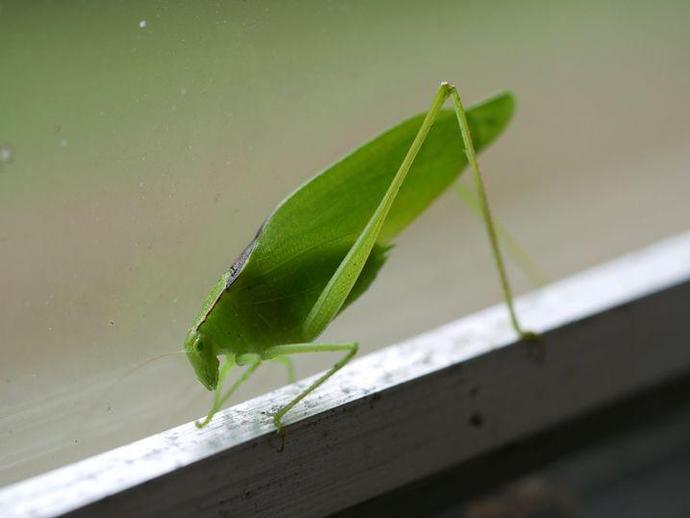
We're reaching into the archives for today's #BenInNature update presented by our friends at ...
August 15, 2021
We're reaching into the archives for today's #BenInNature update presented by our friends at Carter Bank & Trust! The following post was originally published on July 22, 2020. You may not always see katydids, but on summer evenings, you'll definitely hear them! This particular katydid is a male Amblycorypha oblongifolia, also known as the oblong-winged katydid. It can be found from the northeastern U.S. into the midwest. They typically hang out in the understory of deciduous forests and in tall weeds and shrubs, and they feed on goldenrod flowers and other related plants. They don't usually damage important agricultural crops. Since katydids are nocturnal, they rest during the day. When they do, they usually assume a ...

We're reaching into the archives for today's #BenInNature update presented by our friends at ...
August 14, 2021
We're reaching into the archives for today's #BenInNature update presented by our friends at Carter Bank & Trust! The following post was originally published on July 21, 2020. I realize I post a lot of moths, but this is because I love moths and find them endlessly fascinating. Case in point: Eudryas grata, the "beautiful wood nymph" moth. Perhaps the most interesting thing about this moth is that it's a mimic. Believe it or not, Eudryas grata has evolved to resemble bird poop! It might not be the most appealing fashion choice, but if you're a tasty snack, it's handy to look like something that not many critters would ever want to eat. These unique moths can be found across much of the eastern U.S., and the ...

Ben here with the Friday edition of #BenInNature presented by our friends at Carter Bank & Trust!
August 13, 2021
Ben here with the Friday edition of #BenInNature presented by our friends at Carter Bank & Trust! Happy Friday the 13th! Here's another cool critter that we found last week in a man-made tunnel in Alleghany County: Lithobates palustris, the pickerel frog! Pickerel frogs can be found in a large portion of the eastern U.S. and in almost every county in Virginia. While they look very similar to leopard frogs, there are a few differences. The easiest way to tell the difference is that the "spots" on pickerel frogs resemble hand-drawn squares, while the spots on leopard frogs are more circular. Perhaps the most interesting thing about the pickerel frog is its defense mechanism. When stressed, these frogs secrete a ...

It's time for this week's episode of "Museum Minute"!
August 13, 2021
It's time for this week's episode of "Museum Minute"! In this episode, VMNH Educator Terri Robertson is inside the Suzanne M. Lacy Education Center to highlight the museum's Peruvian Cave Roaches! ABOUT MUSEUM MINUTE The Virginia Museum of Natural History has a spectacular assortment of displays within its exhibit galleries! Some displays are unforgettable, while others don't always get the attention they deserve. Through the original series "Museum Minute", museum educators highlight various displays throughout the exhibit galleries, while providing intriguing facts you may not have known. "Museum Minute" is made possible thanks to VMNH Corporate Partners Carter Bank & Trust (www.cbtcares.com) and Boxley Materials ...

Ben here with the Thursday edition of #BenInNature presented by our friends at Carter Bank & ...
August 12, 2021
Ben here with the Thursday edition of #BenInNature presented by our friends at Carter Bank & Trust! Here's another find from the VMNH trip to Alleghany County last week: a salamander found in a small pond near a man-made tunnel! While it's sometimes difficult to identify salamanders to species, this is most likely a seal salamander (Desmognathus monticola), a lungless salamander found throughout a large portion of the Appalachian Mountains. A fairly common species, these salamanders can often be found in mountain streams and spring-fed brooks within their range. This is the second lungless salamander we've looked at this week, and you might be wondering what that term means. Lungless salamanders are salamanders ...
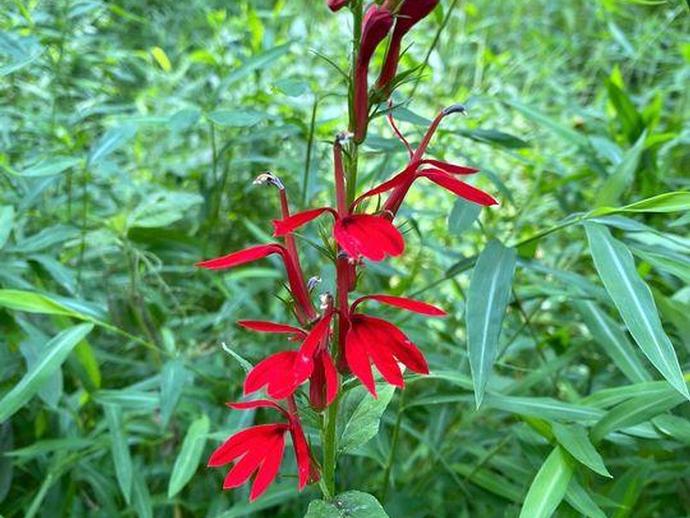
Ben here with today's edition of #BenInNature presented by our friends at Carter Bank & Trust!
August 11, 2021
Ben here with today's edition of #BenInNature presented by our friends at Carter Bank & Trust! Since we looked at a weird parasitic worm yesterday, it seems only fair that we highlight a pretty flower today. This is Lobelia cardinalis, better known as the cardinal flower! Cardinal flower can be found from southeastern Canada down through the eastern and southwestern U.S., and it also continues down to Mexico, Central America, and northern Colombia. While it has a wide range, it can sometimes be difficult to find in the wild, mainly because it's so striking that people have a tendency to over-pick it. The long, tubular flowers of this plant are difficult for many insects to navigate. As a result, this flower is mainly ...

It's time for the Tuesday edition of #BenInNature presented by our friends at Carter Bank & Trust!
August 10, 2021
It's time for the Tuesday edition of #BenInNature presented by our friends at Carter Bank & Trust! This may look like a photo of something that was fished out of a shower drain, but it's actually a living creature! This is a horsehair worm (phylum Nematomorpha), and while its life cycle is a bit gross, it's also quite remarkable! As adults, horsehair worms can be found in water, including not only streams and ponds but also puddles, watering troughs, and swimming pools. They lay their eggs in water, and when the eggs hatch, the larvae form a protective covering and wait around for an insect to eat them. There are hundreds if not thousands of different species of horsehair worms, many of which target specific insects; ...

After weeks away digging for dinosaur fossils in Wyoming ...
August 9, 2021
After weeks away digging for dinosaur fossils in Wyoming, VMNH Assistant Curator of Paleontology Dr. Adam Pritchard is back with a brand new episode of "Tales of Ancient Life"! In this week's episode, Dr. Pritchard puts the spotlight on "Wade" the fossil whale! Special thanks to Carter Bank & Trust (www.cbtcares.com) and Boxley Materials Company (www.boxley.com) for helping make this episode possible! ABOUT TALES OF ANCIENT LIFE Our planet has an incredible story to tell and VMNH Assistant Curator of Paleontology Dr. Adam Pritchard helps share it through his original video series, "Tales of Ancient Life". Dr. Pritchard uses spectacular fossils and other scientific specimens from the museum's paleontology collections to ...

When is a bug a true bug? Find out with entomologist Dr
August 9, 2021
When is a bug a true bug? Find out with entomologist Dr. Art Evans and VPM radio producer Steve Clark as they delve into the characteristics, classification, and proper spelling of the common names of true bugs! This episode is part of the "What's Bugging You?" animated series produced by VPM and Science Matters, a multi-media educational initiative of VPM. To learn more about the series, please visit https://vpm.org/whatsbuggingyou. About Dr. Art Evans Dr. Evans is both a VMNH Research Associate and a member of the Board of Trustees at the Virginia Museum of Natural History. An accomplished entomologist specializing in beetle taxonomy, his published works include "Beetles of Eastern North America," "An Inordinate ...

It's time for the Monday edition of #BenInNature presented by our friends at Carter Bank & Trust!
August 9, 2021
It's time for the Monday edition of #BenInNature presented by our friends at Carter Bank & Trust! Last week, I joined VMNH Associate Curator of Invertebrate Zoology Dr. Kal Ivanov, Myriapodologist Dr. Jackson Means, and Research Technician Extraordinaire Liberty Hightower on a bug hunt in Alleghany County and Giles County. Over the next couple of weeks, I'll be sharing some of my favorite finds from the trip! While we found some cool insects, we also found a lot of really interesting amphibians, such as this little guy: Eurycea longicauda, the long-tailed salamander! We found this salamander inside a tunnel near Moss Run in Alleghany County. That's not too surprising because this species is considered a cave salamander. ...

This past Friday ...
August 9, 2021
This past Friday, a team from VMNH ventured out to look for critters which love the deep, dark corners of the world! The team was made up of Associate Curator of Recent Invertebrates Dr. Kal Ivanov, Myriapodologist Dr. Jackson Means, Science Administrator Ben Williams, and Biology Research Technician Liberty Hightower. The intrepid team explored a man-made tunnel in Alleghany County and New River Cave in Giles County, encountering a multitude of interesting creatures and geological formations. Here we have some pictures of the fascinating environments that the team encountered, and stay tuned for upcoming #BenInNature posts featuring the insects, amphibians, and other creatures that VMNH staff discovered. And, while it is ...

We're reaching into the archives for today's #BenInNature update presented by our friends at ...
August 8, 2021
We're reaching into the archives for today's #BenInNature update presented by our friends at Carter Bank & Trust! The following post was originally published on July 20, 2020. Coccinella septempunctata, the seven-spotted ladybug, is Europe's most common ladybug, but you might be able to find it in your own backyard here in southwest Virginia. These ladybugs were intentionally introduced into North America multiple times between 1956 and 1971 to serve as a biological control of aphids. All of those attempts apparently failed. However, in 1973, a population of seven-spotted ladybugs was discovered in New Jersey. These ladybugs had apparently been accidentally introduced instead of intentionally introduced, and for whatever ...

We're reaching into the archives for today's #BenInNature update presented by our friends at ...
August 7, 2021
We're reaching into the archives for today's #BenInNature update presented by our friends at Carter Bank & Trust! The following post was originally published on July 19, 2020. The grapevine beetle (Pelidnota punctata) is common throughout the central, northern, and eastern U.S., and depending on where you find a grapevine beetle, you might notice some variation! The more southerly grapevine beetles have light brown legs like this one, while grapevine beetles from the north have dark legs. These beetles spend their larval period feeding on decaying logs and stumps. They emerge as adults around July. As the name suggests, these beetles like to feed on both the fruit and the leaves of grapevines, and they aren't picky; ...
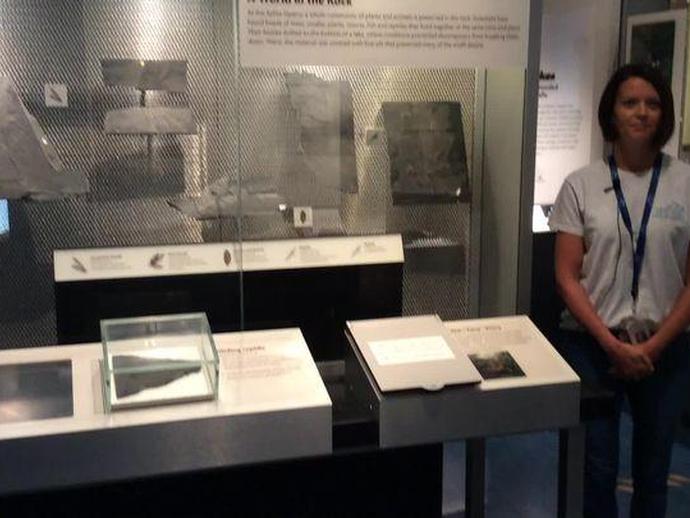
VMNH Education Manager Christy Deatherage is back with a brand new episode of "Museum Minute"!
August 6, 2021
VMNH Education Manager Christy Deatherage is back with a brand new episode of "Museum Minute"! Christy is inside the Uncovering Virginia exhibit this week to highlight Tanytrachelos, an extinct reptile that lived during the late Triassic period around 225 million years ago! ABOUT MUSEUM MINUTE The Virginia Museum of Natural History has a spectacular assortment of displays within its exhibit galleries! Some displays are unforgettable, while others don't always get the attention they deserve. Through the original series "Museum Minute", museum educators highlight various displays throughout the exhibit galleries, while providing intriguing facts you may not have known.

It's time for the Friday edition of #BenInNature presented by our friends at Carter Bank & Trust!
August 6, 2021
It's time for the Friday edition of #BenInNature presented by our friends at Carter Bank & Trust! Behold this adorable eastern fence lizard (Sceloporus undulatus)! Given its tiny size, this little guy must have hatched from its egg pretty recently. Including the tail, these lizards can grow to be as much as 7.5 inches long! The eastern fence lizard is one of the most easily-identifiable lizards in Virginia, and they're also fairly common state-wide. While we have multiple species of skinks (the lizards that have bright blue tails as juveniles and are generally dark in coloration), some of which look extremely similar, there's nothing else in Virginia that really resembles the fence lizard. These lizards can be found in ...

Charlottesville Outreach Educator Bruce Gatling-Austin traveled to nearby Waynesboro yesterday ...
August 5, 2021
Charlottesville Outreach Educator Bruce Gatling-Austin traveled to nearby Waynesboro yesterday to present multiple educational programs to Waynesboro Family YMCA summer campers and the children had a blast! Over 50 campers participated in the programming, which focused on the area's local river ecosystem and highlighted animals from the South River and the importance of water conservation. Just because the museum is located in south central Virginia doesn't mean you have to be nearby to take advantage of our programming! If you're interested in having museum educators provide specialized STEM-based programming for your students, visit www.vmnh.net/education to learn more or contact us today at discover@vmnh.virginia.gov!
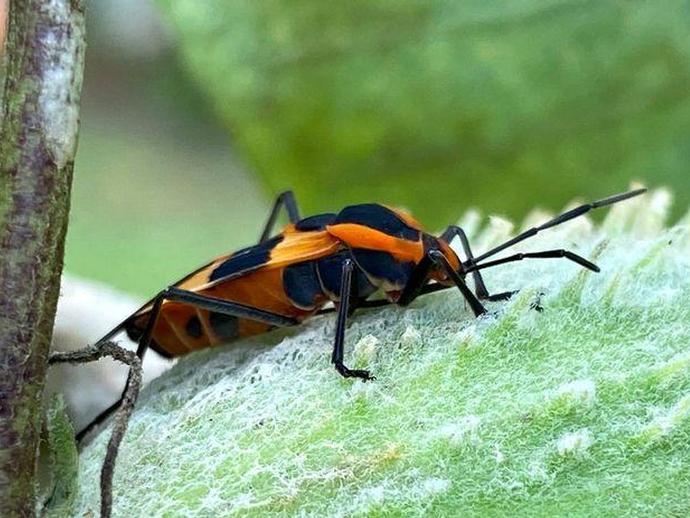
It's time for today's edition of #BenInNature presented by our friends at Carter Bank & Trust!
August 5, 2021
It's time for today's edition of #BenInNature presented by our friends at Carter Bank & Trust! Yesterday we took a closer look at milkweed pods, which are filled with toxic organic compounds called cardiac glycosides. Today, let's look at a critter that feeds on milkweed pods without a care: Oncopeltus fasciatus, the large milkweed bug! Large milkweed bugs have a huge range and can be found throughout most of North America. When feeding on milkweed, these bugs have the unique ability to separate the lipids, proteins, and carbohydrates they need to survive from the toxic compounds; the toxic compounds are sequestered within the milkweed bug and make the bug itself toxic to predators! The striking orange and black ...
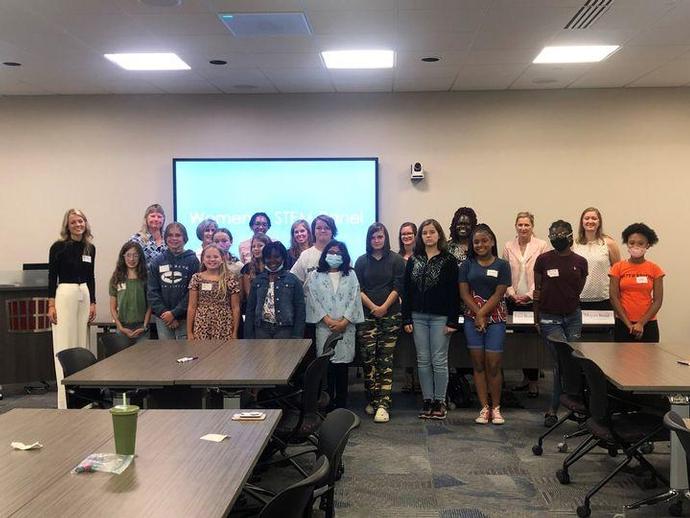
VMNH Curator of Mammals Dr
August 4, 2021
VMNH Curator of Mammals Dr. Nancy Moncrief (back row, first on left) took part in the Institute for Advanced Learning and Research's "Women in STEM: Inspiring the Next Generation" event today in Danville! During a panel discussion geared towards 4th through 8th graders, Dr. Moncrief discussed how she became interested in pursuing a career in science, her path towards achieving it, and her current work as Curator of Mammals at the Virginia Museum of Natural History.
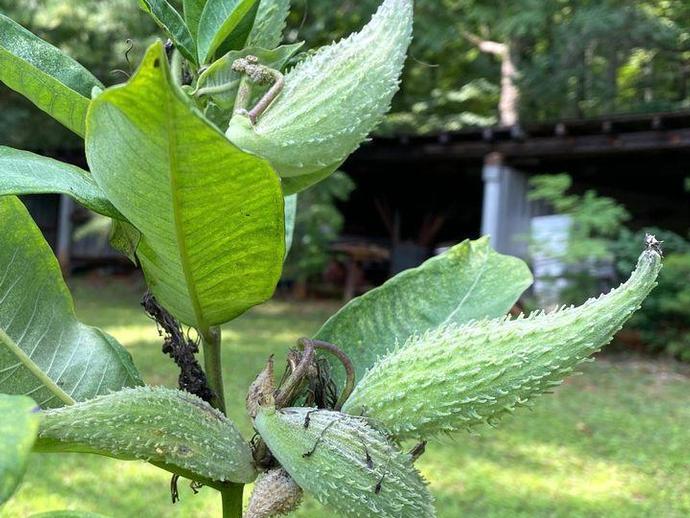
It's time for another edition of #BenInNature presented by our friends at Carter Bank & Trust!
August 4, 2021
It's time for another edition of #BenInNature presented by our friends at Carter Bank & Trust! We've talked in the past about milkweed (genus Asclepias), the perennial flowering plants that are a food source for monarch butterflies (Danaus plexippus) and a nectar source for many different bees and wasps. Today, let's take a look at milkweed pods, the fruits of the milkweed plant that sort of resemble weird little cucumbers! These are young milkweed pods that have yet to dry out, and they're still full of the milky white latex that gives milkweed its name. This liquid contains cardenolides, which are cardiac glycosides, a type of organic compound that can increase the output force of the heart and increase its rate of ...
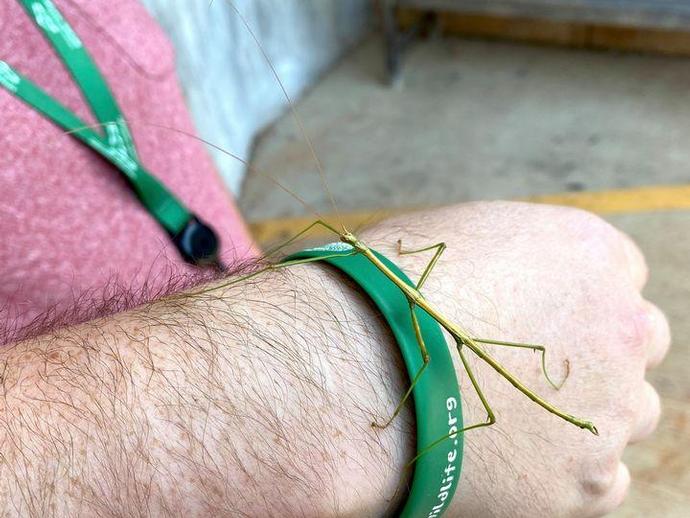
It's time for today's edition of #BenInNature presented by our friends at Carter Bank & Trust!
August 3, 2021
It's time for today's edition of #BenInNature presented by our friends at Carter Bank & Trust! This is the common walkingstick Diapheromera femorata (and the hand of VMNH Myriapodologist Dr. Jackson Means), and this species always reminds me of the terrible old joke: Q: Why don't you see elephants hiding in trees? A: Because they're good at it. The common walkingstick is fairly abundant in the U.S., but I almost never spot them unless they're walking across asphalt or clinging to a building. These insects have evolved to camouflage themselves on trees, and they're very, very good at it! Common walkingsticks are herbivores that skeletonize tree leaves by eating the soft tissue between the leaf veins. Although they're ...
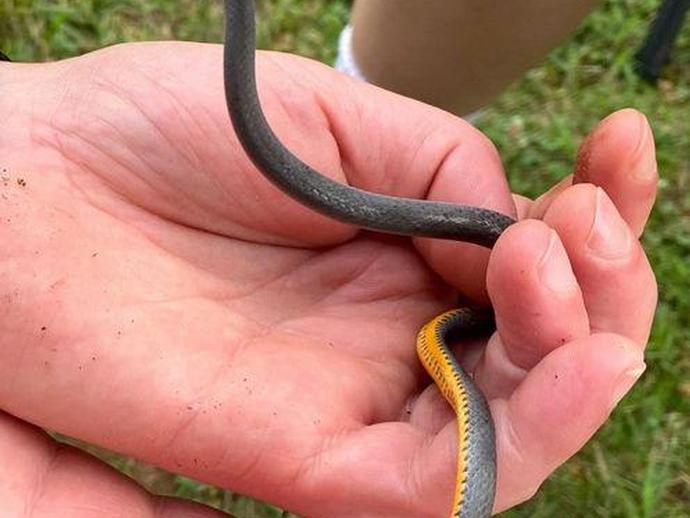
It's time for another edition of #BenInNature presented by our friends at Carter Bank & Trust!
August 2, 2021
It's time for another edition of #BenInNature presented by our friends at Carter Bank & Trust! The ring-necked snake (Diadophis punctatus), seen here being modeled by VMNH Associate Curator of Invertebrate Zoology Dr. Kal Ivanov, is one of my favorite snakes! These little guys are pretty common throughout most of the U.S. and parts of Mexico and Canada, yet you don't see them quite as often as other species. They're rarely seen during the day because they're secretive and mostly nocturnal (just like me; maybe that's why I like 'em so much!). Ring-necked snakes feed on a wide variety of prey species depending on what's available, including earthworms, slugs, frogs, lizards, and salamanders. Although they're never listed ...

We're reaching into the archives for today's #BenInNature update presented by our friends at ...
August 1, 2021
We're reaching into the archives for today's #BenInNature update presented by our friends at Carter Bank & Trust! The following post was originally published on July 18, 2020. Please enjoy this nest of fledgling eastern phoebes (Sayornis phoebe) as they stare at my camera in confusion! Phoebe nests are fairly distinctive, as they have a mud base and are lined with moss and grass. They're usually built in crevices, whether on a rock or on a man-made structure (like my grandma's front porch). Phoebes are migratory birds, spending the winters in the southern U.S. and even down to Central America! They're one of the first birds to return to their breeding grounds in the spring and one of the last to leave in the fall. ...
Archives
2026
2025
2024
2023
2022
2021
2020
2019
2018
2017
2016
2015
2014
2013
2012
2011
2010
2009
2008

Please Visit Us Soon
Hours:
Tuesday - Saturday: 10am - 4pm
Sunday: Noon to 4pm (Memorial Day Weekend through Labor Day Weekend only)
Monday: Closed
Admission:
$12 for ages 18-59
$6 for ages 3-17, seniors 60+, and college students
FREE for children under 3, museum members, members of ASTC Passport participating institutions, and EBT cardholders
My 4 year old son loves going to the museum. The exhibits are educational, interactive and kid-friendly.
”

 Hours & Admissions
Hours & Admissions Directions
Directions